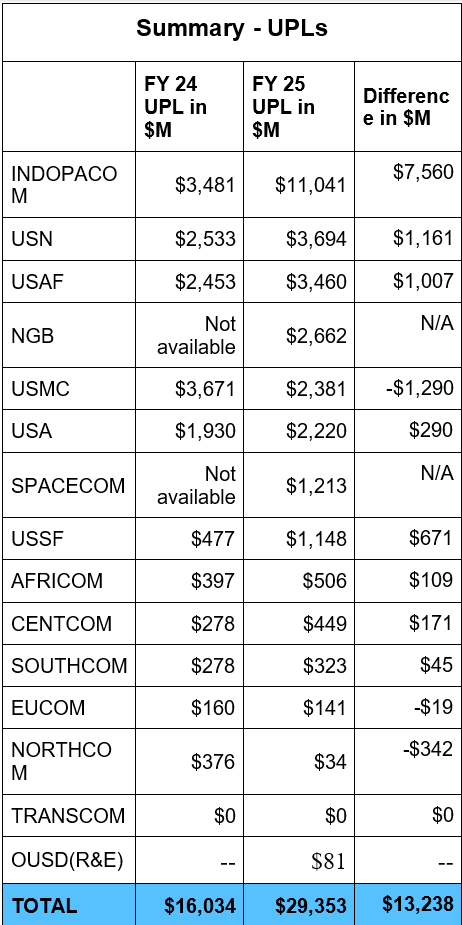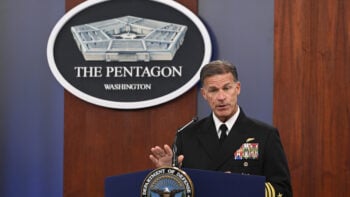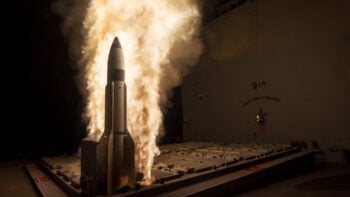
On March 11, 2024 the Pentagon and military services presented their fiscal year 2025 budget requests. (Graphic by Breaking Defense, original images courtesy DVIDS, Getty)
Over the last month, Breaking Defense has published a series of reports on the unfunded priority lists from the military services and combatant commands. In a new analysis, Mark Cancian and Chris Park analyze the lists as a group, highlighting common themes and the reasons behind the requests.
Celebrated by defense hawks, reviled by defense skeptics, and ignored by OSD leadership, the annual unfunded priority lists (UPLs, or “wish lists”) get attention as indicators of where holes exist in the defense budget. This year’s lists total a near-record high of $29.4 billion, driven by an ambitious national defense strategy, a defense top line that does not keep up with inflation, and an unstable world that demands attention.
Although each list reflects the specific needs of the issuing institution, an analysis of the collected UPLs shows a few themes carried across all the lists: no additional military personnel, concerns about a rising and increasingly aggressive China, risks in other theaters, and the need to replenish stockpiles of missiles and spare parts.
The lists began in the 1990s as a way for defense hawks and the Republican opposition to highlight risks in defense and embarrass the Clinton administration in the process. The motivation and the lists have continued — Defense hawks use them to point out items that should get funding, while the opposition party uses them to argue that the administration is not a good steward of national security.
The requirement is now established in law, 10 USC 222a, directing a list within ten days of the budget submission, covering “[any] program, activity, or mission requirement not funded in the budget of the President, [that] is necessary to fulfill a requirement associated with an operational or contingency plan of a combatant command or other validated requirement; and would have been recommended for funding through the budget if additional resources had been available.” Thus, every year after the President submits the budget, each military service, combatant command, and a few defense agencies send Congress their UPLs.
The lists are not universally popular: Defense skeptics hate the lists because they imply the need for more money. (Sen. Elizabeth Warren, D-Mass., has led attempts to repeal the statutory requirements, without success.) And the Pentagon’s civilian leadership has consistently opposed such lists because they undercut the president’s budget.
Consequently, the Pentagon refuses to bureaucratize the process, so there is no standardized format. Each UPL lists items according to their priority, as required by the statutory language, but in whatever format the issuing institution desires. Thus, the Marine Corps submitted a single-page document listing 34 items. The Navy, on the other hand, provided a paragraph-long justification for each item. European Command (EUCOM) sent eight pages describing $141 million. The Army submitted a single page for $2.2 billion.
A Near-Record Total
Fourteen UPLs are available publicly. (The Missile Defense Agency, which normally submits one, did not even do a rollout briefing and is unlikely to submit a UPL at this late date, while Special Operations Command’s list has not come to public yet.) The 14 UPLs total $29.4 billion, a near-record amount that clashes with the Fiscal Responsibility Act of 2023 (FRA). The FRA, passed last year to avoid a default on US government debt, caps the defense budget at a one percent increase ($850 billion). If Congress funded all items on the UPLs, the FY25 defense budget would reach $879 billion — compared to the president’s budget request for FY 2025 (PB25). This would represent a 4.4 percent increase from the enacted FY 2024 budget ($842 billion), outpacing inflation by about 1 percent.
The recent history of UPLs shows amounts going up and down with no particular pattern. It does not reflect guidance because neither Congress nor DoD provides any. It may reflect a lagging view of budget needs, lower after a few years of budget increases, higher after budget caps.
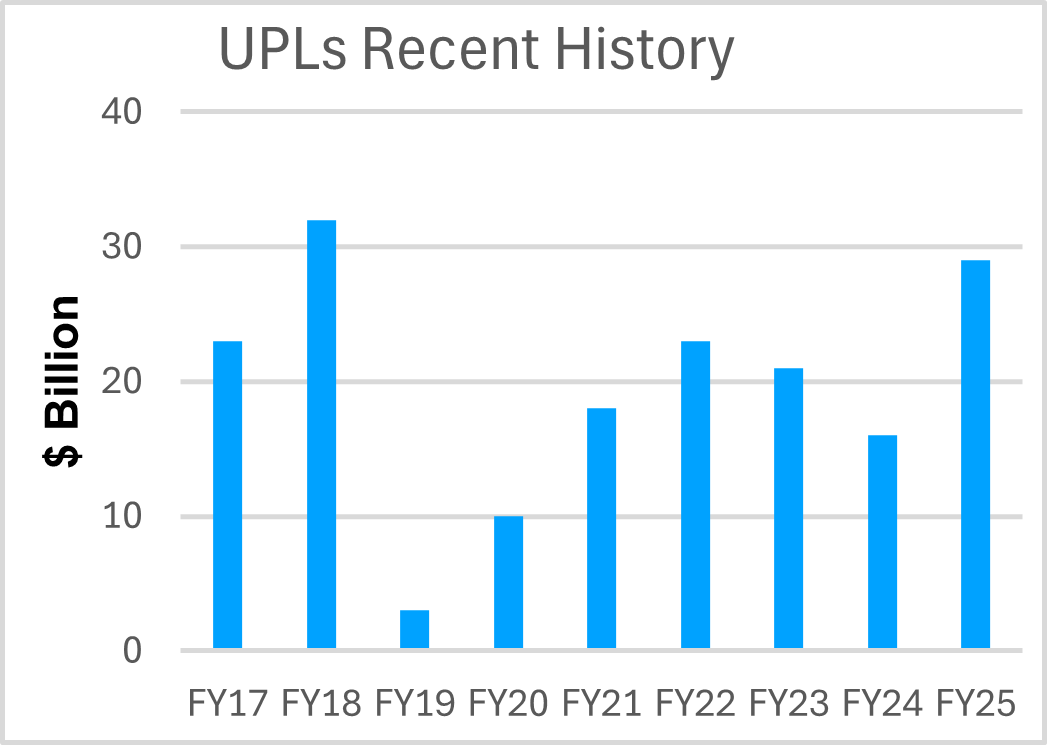
Note: Few FY19 UPLs were published, while those published reached historically low levels.
Who Is Driving This Year’s Near-Record Amount?
The answer is clear: Indo-Pacific Command (INDOPACOM). INDOPACOM’s $11 billion UPL is by far the largest and comprises 42 percent of the total — nearly equal to all the military services.

Shortfalls identified in the INDOPACOM theater are not limited to the combatant commander’s list. The Military services also ask for funds for exercises, military construction (MilCon), and other activities in the INDOPACOM theater. This is not surprising for the theater facing China’s “pacing” challenge. However, the large amount, on top of the $9.9 billion Pacific Deterrence Initiative, raises questions about whether the president’s budget can handle strategic competition with China as well as the other demands of a global superpower. The real-world answer may ultimately be: no.
Requests by the other combatant commands were far smaller.
EUCOM repeated last year’s request to acquire air base defense systems because of heightened concerns about vulnerability as a result of its experience in the Ukraine War. The request notes that PB25 accepted risks in the European theater as the Air Force prioritized air defense capabilities for Indo-Pacific bases. Here, as in other places in the budget, the tension between a focus on the Pacific and the global commitments of a superpower becomes manifest. The Pentagon’s National Defense Strategy says that the Pacific gets priority, but EUCOM is facing an immediate threat.
Transportation Command did not provide a list again this year. Given its long history of empty lists, this appears to be a deliberate organizational decision rather than a response to the specifics of this year’s budget proposal. Cyber Command and Strategic Command also did not submit lists, asking instead that the base budget be fully funded.
What Do The Services And Combatant Commands Want Most?
The chart below compares the UPLs with the base budget as percentages of the whole. Noteworthy is the relatively small amount of personnel funding requested in the UPLs and the large amount for military construction (MilCon).
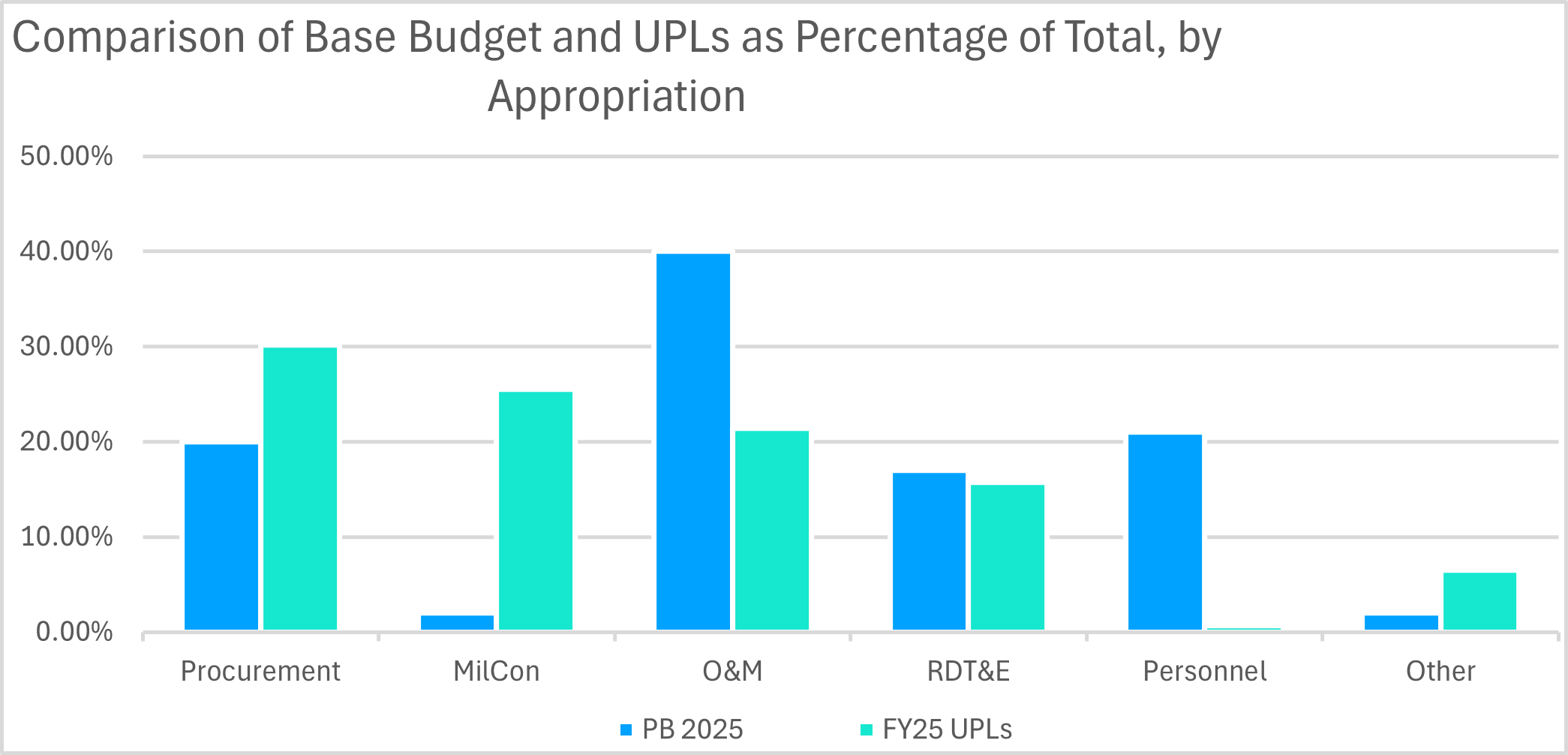
Personnel ($0.1 billion) — A Noteworthy Absence
The lack of requests for additional personnel is striking. Personnel costs are 21 percent of the budget but a negligible percent of the UPLs. PB25 would cut the active-duty strength by 7,800 though increasing the reserve component by 2,100 as a partial offset. None of the services requested more active-duty personnel in their UPLs. The National Guard Bureau did submit a UPL for more personnel, mostly additional recruiters to help maintain the total personnel numbers. These would mostly be personnel shifting from part-time to full-time.
Recruiting difficulties make increasing the number of personnel difficult in any case, as does hesitation in taking on the long-term commitment that additional military personnel would constitute.
This also reflects a tension in the National Defense Strategy. On the one hand, the defense strategy calls for trading off force structure for modernization. The Army, Navy, and Air Force all get smaller in line with this strategy. Nevertheless, all the services note how busy they are, with many operational deployments and engagements with partners and allies. Resolving to do the same amount of work with fewer people only goes so far.
Military Construction ($7.4 billion) And Facilities Maintenance — A Disproportionately Large Amount
MilCon is perennially underfunded, being less glamourous than capital accounts that buy weapons or munitions. The services also expect that Congress will add money, amounting to $1-2 billion in typical years. It is no surprise, then, that the MilCon amount in the UPLs is the second largest of all the appropriations.
Most of the additional MilCon funding requested would support projects to improve the US footprint in the Indo-Pacific. INDOPACOM, seeking $3.3 billion, identified missing funding for facility upgrades — for example, Micronesia’s Yap Airfield runway extension — to improve theater access. Notably, neither the base budget nor the UPLs included hardened aircraft shelters, despite their utility in defending against a missile attack. The Air Force instead has focused on dispersion.
Other requests responded to embarrassing reports about deteriorating barracks and family housing. The defense budget requested $2.3 billion in barracks and family housing construction. The Marines nevertheless identified shortfalls in barracks improvement as its top unfunded priority. The Air Force listed funding for dining facilities and child development centers.
Procurement ($8.8 billion)
To meet the lower FRA caps, DoD cut $8 billion from the FY25 procurement request compared to what was projected in FY24. These URLs would, in effect, put that money back in.
The UPLs request $3 billion for aircraft-related procurement, including funds to buy 14 additional aircraft. This responds to the unusually small number of aircraft in the base budget. The Air Force requests only 82 aircraft, and the Navy 75. The Air Force and Navy would need about 250 aircraft annually to maintain their current inventories. Yet, even with the UPLs, the total number of aircraft procured would not be adequate.
Neither the Air Force, the Navy, nor the Marine Corps requested any fighters, including F-35s. The National Guard Bureau notably requested six additional F-15EX and six F-35s. The National Guard is particularly sensitive to the level of aircraft procurement because it flies the oldest aircraft. It worries that without regular aircraft upgrades, its aircraft may be deemed obsolescent, and its units unfit for operations on modern battlefields.
The lack of aircraft procurement might seem to indicate that the services are shifting to uncrewed systems. However, there are only $250 million of UPL requests for such systems.
PB25 requests $29.8 billion for munitions procurement, $16 billion of which is for tactical missiles. On top of that, the services and combatant commands identified a $2.3 billion shortfall to procure additional Tomahawks, Long-Range Anti-Ship Missiles, and other missiles needed for a potential war in the Indo-Pacific. Although there is a strong analytic case for buying more munitions, production constraints likely mean that industry could not accommodate all these requests, even if the money were available.
The Navy’s most interesting item was what was not on its list: a submarine. The Navy cut a submarine in PB25, breaking from the plan to procure two attack submarines per year. It did not even hint that Congress should add the submarine back. This is likely a result of reported shipbuilding delays. There is no point in adding money for ships that the industrial base cannot build.
Instead, the Navy requested $403 million to bolster the submarine industrial base. Designated as the top priority, this request may also help AUKUS implementation. As Breaking Defense reported earlier, this may be a backup for the $3.4 billion designated for the submarine industrial base in the Ukraine/Israel/border security supplemental.
Across the board, the US military seeks to adapt to drone warfare observed in Ukraine and the Middle East, particularly after the deadly attack on the US military desert outpost in Jordan. The Army, CENTCOM, EUCOM, and AFRICOM requested over $680 million to develop and acquire several counter-unmanned aerial systems (c-UAS) systems. This was on top of more than $800 million for c-UAS in the base budget.
Mine warfare in the Black Sea has provided a reminder of how important these weapons can be. Thus, INDOPACOM requests an additional $482 million to procure mine systems. PB25 includes $100 million for the Navy to procure maritime mines, nearly double the $58.8 million in the FY24 budget but still far below what is needed. Mine warfare, particularly offensive mine warfare, remains a perennially under-resourced area.
Operations And Maintenance ($6.2 billion)
O&M needs are nearly insatiable since they cover the full scope of operations, readiness and training. The Army, the Air Force, and INDOPACOM requested nearly $1 billion for “campaigning” in the Indo-Pacific. These funds would support military exercises in the region, enabling, for example, the Air Force to test its new operational concept.
The Navy seeks funds to recertify older SM-2 missiles in the stockpile and procure new ones, as the missiles are used to intercept Houthi missiles in the Red Sea. Some of these replacement missiles may get funded in the Ukraine/Israel supplemental.
Research, Development, Test, And Evaluation ($4.6 billion)
The Research, Development, Test, and Evaluation (RDT&E) request (17 percent of the total UPLs) is in line with the RDT&E proportion in the base budget (16 percent).
The UPLs submitted by the Space Force and Space Command skewed heavily towards RDT&E, with over 70 percent of the identified shortfalls in this category. This reflects the capital-intensive nature of space operations. Space Force’s base budget is 78 percent acquisition and 63 percent RDT&E alone.
Does It Matter?
The UPLs are less meaningful this year because last year’s budget agreement constrains the defense FY25 budget top line. Given the current political balance, Congress is unlikely to break the caps. Republican deficit hawks are so powerful in the House that just getting a defense budget at the cap level may be a challenge. As a result, funding items on the lists would have to come from cuts elsewhere, which is difficult.
Still, committees find some savings every year, so a few items will get funded. Some of the MilCon needs will be tempting for members anxious to highlight local impact. Since many of these items also fix high-visibility quality-of-life problems, there is a dual incentive.
Some crisis could change the defense budget environment. This would have to be substantial enough to induce some anxiety about preparedness. However, given Russia’s ongoing aggression in Europe, Iran’s increasingly open aggression in the Middle East, and China’s military buildup, something could happen. As Republicans and even some Democrats deem the Biden Administration’s $850 billion FY25 budget request to be inadequate, there might be an opening for the UPLs.
Finally, the election in November might substantially change the political balance of power, especially when — if trends persist — Congress may not pass the FY25 budget until the next president is in office. If the Biden administration wins a second term, they might increase defense as part of budget increases across the board, defense and nondefense. A second Trump administration is harder to read. The first Trump administration began with large multiyear defense increases but ended with the deficit hawks in charge and a flat outyear projection.
UPLs are like wait lists for college admissions. The institution states its highest priorities (admits), lower priorities (waitlist), and lowest priorities (rejects). At least some people will get in from the waitlist, so everyone hopes for good news and fights for one of the lucky places.
Mark Cancian is a retired Marine colonel now with the Center for Strategic and International Studies (CSIS). Chris H. Park is a CSIS research assistant.
















